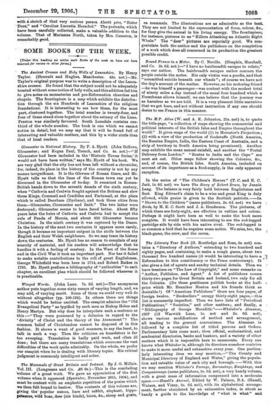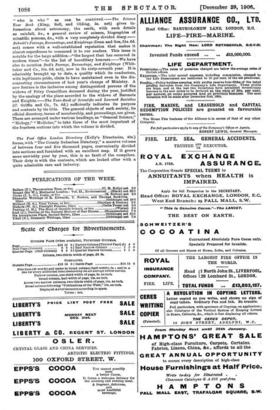The Literary Year Book (G. Routledge and Sons, 5s. net)
con- tains a "Directory of Authors," extending to two hundred and eighty pages, and containing, to make a rough guess, about two thousand five hundred names (it would be interesting to have a Referendum to this constituency re the Times controversy). It also gives a list of agents and sundry technical details. Then we have treatises on "The Law of Copyright," and some remarks on "Author, Publisher, and Agent." A list of publishers covers thirty-two pages for Great Britain and Ireland, two only for all the Colonies. (Do these gentlemen publish books at the half- price which Mr. Henniker Heaton and his friends think so desirable ?) Of "American Publishers" there are four pages, of foreign twelve. "Booksellers" occupy thirty-eight pages,—this list is necessarily imperfect. Then we have lists of "Periodical Publications," "Societies," and other matters ; and finally, a "Bibliography of George Meredith."— Whitaker's Almanac, 1907 (12 Warwick Lane, Is. net and 2s. ad. net), shows various modifications of method and arrangement, all tending to the general convenience. The Almanac is followed by a complete list of titled persons and Orders. Parliamentary lists come next; then official, ecclesiastical, and academical directories, banks and bankers, and a variety of other matters which it is impossible here to enumerate. Every one knows what Whitaker is, although its directors somehow contrive to make it more useful and exhaustive every year. One particu- larly interesting item we may mention,—" The County and Municipal Directory of England and Wales," giving tho popula- tion and rateable value of each city and borough.—With this we may mention Whitaker's Peerage, Baronetage, Knightage, and Companionage (same publishers, 3s. 6d. net), a very handy volume, with a great mass of information compressed into a moderate space.—Hazdt's Annual, Edited by W. Palmer, BA. (Hazel, Watson, and Viney, 3s. 6d. not), with its alphabetical arrange- ment, further elucidated by an exhaustive index, is about as handy a guide to the knowledge of "what is what" and " who is who " as can be contrived.—The Science Year Book (King, Sell, and Olding, as. net) gives in- formation about astronomy, the earth, with such details as rainfall, &c., a general review of science, biographies of scientific persons, &c., with a very completely divided diary.— Debrett's Peerage, Baronetage, and Knightage (Dean and Son, 31s. 6d. net) comes with a well-established reputation that makes it almost superfluous to commend it to our readers. This issue is notable for the large addition—"the largest that has occurred in modern times "—to the list of hereditary honours.—We have also to mention Dod's Peerage, Baronetage, and Knightage (Whit- taker and Co., 10s. ad. net), now in its sixty-seventh year. It is admirably brought up to date, a quality which its conductors, with legitimate pride, claim to have maintained even in the dis- concerting circumstances of last year's change of Ministry. A new feature is the inclusion among distinguished persons of the widows of Privy Councillors deceased during the year, justified by the analogy of the place accorded to the widows of Baronets and Knights.—The Year-Book of Scientific and Learned Societies (C. Griffin and Co., 7s. 6d.) sufficiently indicates its purpose and contents by its title. The general objects of each society, its official directory, terms of membership, and proceedings, are given. These are arranged under various headings, as "General Science," "Biology," "Medicine," to take three of the most important of the fourteen sections into which the volume is divided.



































 Previous page
Previous page